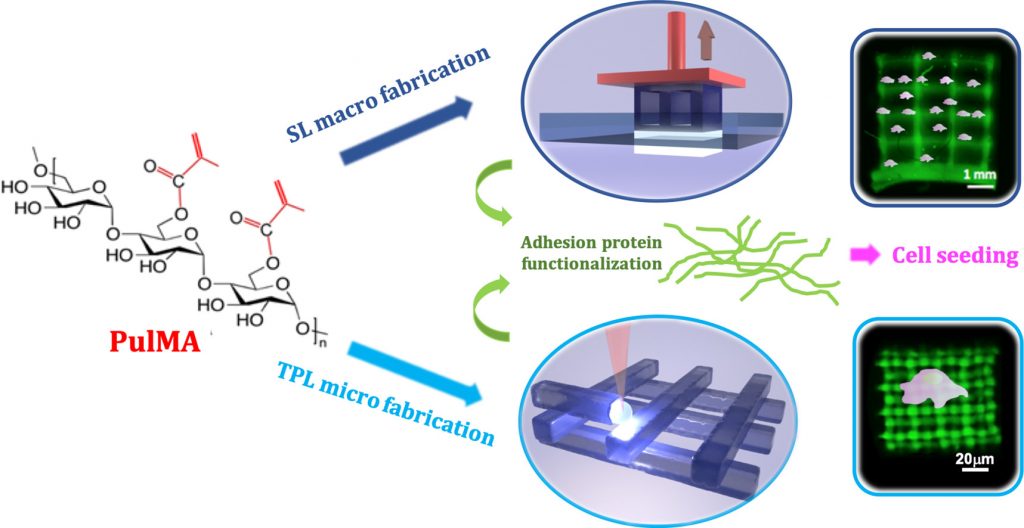Biomimetic hydrogels offer several opportunities in medical applications, according to a group of researchers in a paper entitlted “Polysaccharide hydrogels for multiscale 3D printing of pullulal scaffolds.” But the generation of synthetic microenvironments that simulate the effects of natural tissue niches on cell growth and differentiation requires new methods to control hydrogel feature resolution, biofunctionalization and mechanical properties. In the paper, the researchers show how this can be achieved by using a 3D printable pullulan-based hydrogel with tunable mechanical properties.
Pullulan is a non-ionic linear polysaccharide that is naturally produced from starch. It has many advantages: it is biodegradable, edible, bio- and blood-compatible, non-toxic, non-immunogenic, non-mutagenic and non-carcinogenic, as well as being easily soluble in water, which allows a clear and viscous hydrogel to be prepared. It has been proposed as an anti-adhesive barrier layer for the prevention of postoperative problems, and is widely used in cosmetics. It has anti-free-radical properties and has been used in nanofibers or coatings for food preservation, as well as in applications in tissue engineering and regenerative medicine.
“We reasoned that pullulan could be custom modified on its hydroxyl groups with desired chemical moieties (for example chemical polymerizable groups) in order to generate 3D crosslinked structures of tunable mechanical properties,” the researchers state. “Indeed, in spite of these attractive chemical features, the potential of pullulan for the generation of scaffolds or culture systems with specific 2D and 3D shapes and morphologies has so far remained unexplored.”
The researchers synthesized methacrylated pullulan (PulMA) hydrogels that had been printed by multiscale light assisted 3D printing techniques. Using stereolithography and two-photon lithography, they produced 3D patterns from millimeters down to a few microns as well as suspended structures.
“Using further engineering the material into a photosensitive formulation, we built complex 3D shapes through spatially controlled irradiation (SL), overcoming current limitations in structuring along the third dimension,” they continue. “Mechanical properties, in particular rigidity, were controlled by the addition of a bifunctional crosslinker that enabled to tune elastic modulus and water absorption of PulMA hydrogels.”
Cell lines and mesenchymal stem cells (MSCs) were seeded both on micro- and macro-metric 3D structures to test biological response. Testing showed that the cells were viable and metabolically active, adhering only when in the presence of fibronectin or fibrin functionalization.
“As the integration of multi-scale patterns in the same structure can be an important step forward in tissue engineering and regenerative medicine fields and hydrogel fabrication with these two different scale sizes and technologies have not commonly reported, this study confirms PulMA hydrogels as excellent substrate supporting cell culture after proper functionalization, with endowed mechanical properties and 3D printing feature sizes,” the researchers conclude. “On the other hand, the non-adhesive property of PulMA could allow to fine tuning of adhesive areas and patterning of individual cells and of monolayers in both 2D and 3D, giving vast opportunities for cell engineering through microfabrication. In future, fabrication by SL and TPL in presence of pre-embedded cells is potentially feasible with PulMA at no or low toxicity given the use of visible and infrared radiation, respectively.”
Authors of the paper include G. Della Giustina, A. Gandin, L. Brigo, T. Panciera, S. Giulitti, P. Sgarbossa, Delfo D’Alessandro, Luisa Trombi, Serena Danti and G. Brusatin.
Discuss this and other 3D printing topics at 3DPrintBoard.com or share your thoughts below.
Subscribe to Our Email Newsletter
Stay up-to-date on all the latest news from the 3D printing industry and receive information and offers from third party vendors.
You May Also Like
Precision at the Microscale: UK Researchers Advance Medical Devices with BMF’s 3D Printing Tech
University of Nottingham researchers are using Boston Micro Fabrication‘s (BMF) 3D printing technology to develop medical devices that improve compatibility with human tissue. Funded by a UK grant, this project...
3D Printing Webinar and Event Roundup: April 21, 2024
It’s another busy week of webinars and events, starting with Hannover Messe in Germany and continuing with Metalcasting Congress, Chinaplas, TechBlick’s Innovation Festival, and more. Stratasys continues its advanced training...
3D Printing Webinar and Event Roundup: March 17, 2024
It’s another busy week of webinars and events, including SALMED 2024 and AM Forum in Berlin. Stratasys continues its in-person training and is offering two webinars, ASTM is holding a...
3D Printed Micro Antenna is 15% Smaller and 6X Lighter
Horizon Microtechnologies has achieved success in creating a high-frequency D-Band horn antenna through micro 3D printing. However, this achievement did not rely solely on 3D printing; it involved a combination...
































